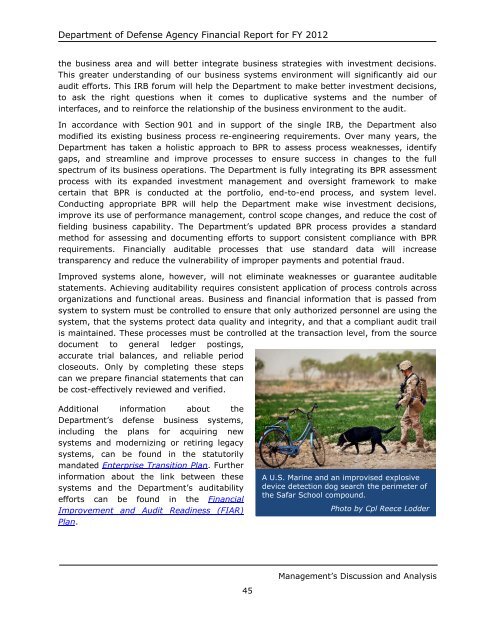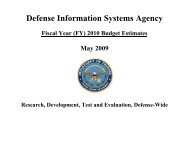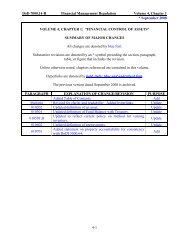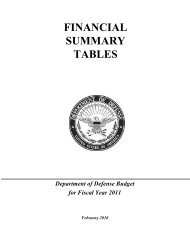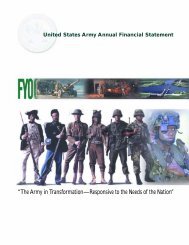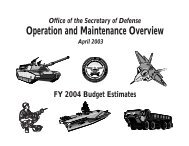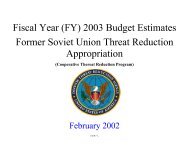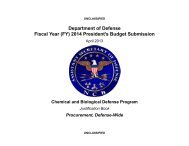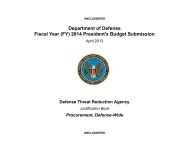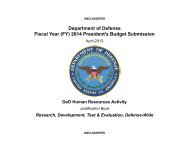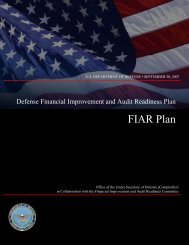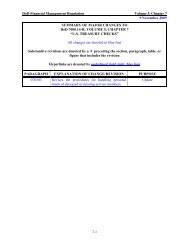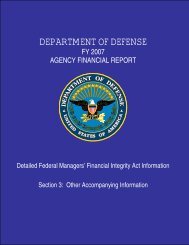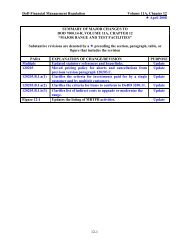department of defense agency financial report fiscal year 2012
department of defense agency financial report fiscal year 2012
department of defense agency financial report fiscal year 2012
Create successful ePaper yourself
Turn your PDF publications into a flip-book with our unique Google optimized e-Paper software.
Department <strong>of</strong> Defense Agency Financial Report for FY <strong>2012</strong><br />
the business area and will better integrate business strategies with investment decisions.<br />
This greater understanding <strong>of</strong> our business systems environment will significantly aid our<br />
audit efforts. This IRB forum will help the Department to make better investment decisions,<br />
to ask the right questions when it comes to duplicative systems and the number <strong>of</strong><br />
interfaces, and to reinforce the relationship <strong>of</strong> the business environment to the audit.<br />
In accordance with Section 901 and in support <strong>of</strong> the single IRB, the Department also<br />
modified its existing business process re-engineering requirements. Over many <strong>year</strong>s, the<br />
Department has taken a holistic approach to BPR to assess process weaknesses, identify<br />
gaps, and streamline and improve processes to ensure success in changes to the full<br />
spectrum <strong>of</strong> its business operations. The Department is fully integrating its BPR assessment<br />
process with its expanded investment management and oversight framework to make<br />
certain that BPR is conducted at the portfolio, end-to-end process, and system level.<br />
Conducting appropriate BPR will help the Department make wise investment decisions,<br />
improve its use <strong>of</strong> performance management, control scope changes, and reduce the cost <strong>of</strong><br />
fielding business capability. The Department’s updated BPR process provides a standard<br />
method for assessing and documenting efforts to support consistent compliance with BPR<br />
requirements. Financially auditable processes that use standard data will increase<br />
transparency and reduce the vulnerability <strong>of</strong> improper payments and potential fraud.<br />
Improved systems alone, however, will not eliminate weaknesses or guarantee auditable<br />
statements. Achieving auditability requires consistent application <strong>of</strong> process controls across<br />
organizations and functional areas. Business and <strong>financial</strong> information that is passed from<br />
system to system must be controlled to ensure that only authorized personnel are using the<br />
system, that the systems protect data quality and integrity, and that a compliant audit trail<br />
is maintained. These processes must be controlled at the transaction level, from the source<br />
document to general ledger postings,<br />
accurate trial balances, and reliable period<br />
closeouts. Only by completing these steps<br />
can we prepare <strong>financial</strong> statements that can<br />
be cost-effectively reviewed and verified.<br />
Additional information about the<br />
Department’s <strong>defense</strong> business systems,<br />
including the plans for acquiring new<br />
systems and modernizing or retiring legacy<br />
systems, can be found in the statutorily<br />
mandated Enterprise Transition Plan. Further<br />
information about the link between these<br />
systems and the Department’s auditability<br />
efforts can be found in the Financial<br />
Improvement and Audit Readiness (FIAR)<br />
Plan.<br />
45<br />
A U.S. Marine and an improvised explosive<br />
device detection dog search the perimeter <strong>of</strong><br />
the Safar School compound.<br />
Photo by Cpl Reece Lodder<br />
Management’s Discussion and Analysis


